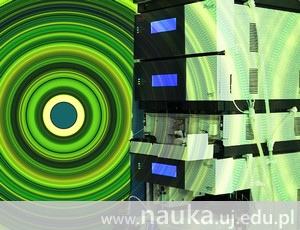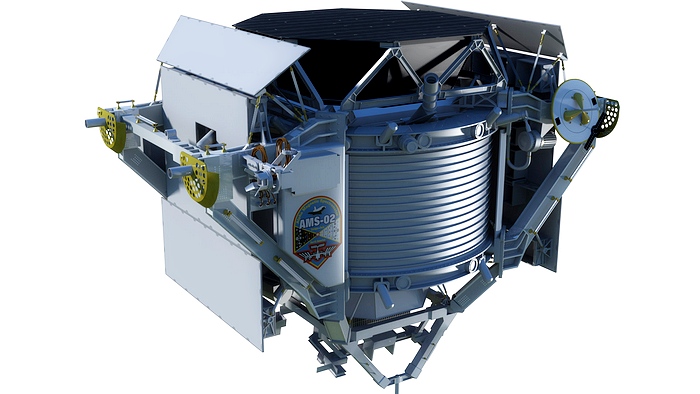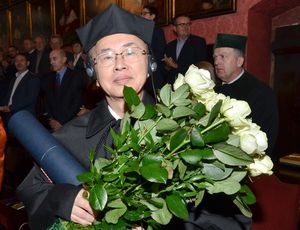
What’s the link between a breathalyser, the Orion Nebula and magnetic resonance? It seems that these concepts have little in common. And yet, they are all related to spectroscopy, which measures the interaction between light (both visible and invisible) and matter, understood as a conglomeration of atoms and molecules.
In order to better understand how this method works, let’s take a closer look at the simplest prismatic spectroscope. It resembles a small telescope in which we’ll see all colours of the rainbow if we look into it in a well-lit room. It’s because what constitutes the main part of a spectroscope is a light dispersing component, such as a prism or a diffraction grating. If we looked through a spectroscope at a neon sign of a roadside bar, we would observe a slightly jagged rainbow, consisting only of solitary coloured stripes. What we see is the emission spectrum, which is different for each element. Every element and chemical compound shines differently.
This apparently not very advanced method has allowed children to enjoy colourful balloons floating at fairs. The helium that fills them was discovered during spectroscopic research on the solar spectrum – the scientists saw a stripe which did not match any of previously known elements.

AMS Spectroscope delivered to the International Space Station by NASA in 2011. Its main purpose is to study the history of the universe
Yet, it is difficult to speak about spectroscopy as a single, specific method. It’s a field that refers to all possible interactions between electromagnetic radiation, such as radio waves or infrared, and matter. Electromagnetic radiation differs in terms of wave length, so it is necessary to use diverse measuring equipment. Spectroscopy using electromagnetic radiation of different energy ranges provides completely different information about the studied matter.
Infrared on the track of chemical compounds
One of the types of spectroscopy is the infrared spectroscopy (IR), primarily used in the qualitative analysis of chemical compounds. Infrared radiation consists of waves situated between visible light and radio waves. Every body whose temperature is higher than absolute zero (higher than 273.15°C) emits this type of radiation.
In order to obtain a constant infrared radiation source, an object is heated to a temperature above 1000°C. The resultant stream of light goes through a system of mirrors, which splits it into two beams. One of them is directed towards the studied sample, and the second one – for calibration purposes - towards a control sample (for instance, a solvent). In the temperature above absolute zero, atoms in molecules vibrate. If the frequency of radiation falling on a sample is analogous to the frequency with which atoms vibrate, radiation will be absorbed by the molecule. This, in turn, will increase the range of molecular vibration.
To put is simply, bonds can be pictured as vibrating springs. It’s only when we supply the springs with the sufficient amount of energy that they will absorb it and start to vibrate more intensely. In physics, this phenomenon is known as resonance. As different bonds are characterised by specific vibration energies, IR spectroscopy allows to identify the functional group present in a given compound, which provides the basis for the classification of compounds. By comparing the obtained spectra with available databases, it’s possible to identify these substances. The method has been applied in the aforementioned stationary breathalysers used at police stations and courtrooms. Mobile breathalysers using IR spectroscopy, which enable officers to examine as many as five drivers per minute, are also becoming more and more popular.
We’ve asked Prof. Yukihiro Ozaki from Kwansei Gakuin University, Japan*, about the role spectroscopy is going to play in the future.

Recently, it is attempted here and there to connect a spectrometer with a smartphone. One can use this sort of system for example, in a factory, a hospital, a farm, on board, and even at home for various purposes such as qualitative and quantitative analysis, quality control, medical examination, growth test, and identification.
In the near future, a spectrometer may come into our houses. Attached to the toilet bowl it provides information about the concentration of urinary albumin and blood sugar in urine. Furthermore, whereas placed in a refrigerator, it measures the freshness of foods. A spectrometer can also measure the contamination of indoor air. It has also been planned to install a spectrometer in a drone. If this would go well, we will be able to measure, for example, the extensive contamination in oceans, as well as check the growth of fruits in a large orchard without human hands.
* Prof. Yukihiro Ozaki – a world famous chemist, expert in molecular spectroscopy, who has conducted pioneering research on the development of modern spectroscopic methods. He has obtained honorary doctorate from the Jagiellonian University and has been a long-time collaborator of the JU Institute of Chemistry.
Spectroscopy is used to study works of art, detect heavy metals in drinking water, or identify complex structures in the outer space. In 2014 NASA published a database concerning Polycyclic Aromatic Hydrocarbons (PAH) - compounds that played a major role in the beginnings of life on earth. The data was obtained by means of IR spectroscopy.
Everyday spectroscopy
Spectroscopy is applied in almost all disciplines and the method is being constantly improved. There already exist small portable spectrometers fitted with the microelectromechanical system (MEMS), which make it possible, for instance, to examine the quality of soil without marking samples and waiting for the results of a laboratory study. Another advantage of these devices is that they are five times cheaper to produce than traditional ones.
Research aimed at reducing the size of a IR spectrometer, so that it can be installed in a typical smartphone, is underway. Such devices could be used during shopping to assess the quality of food products – for instance to check whether an apple is sweet, meat is fresh, and chocolate contains as much cocoa as stated on the packaging. This would allow quick identification of ingredients with the help of a large database, which could be expanded to a point that it is used to scan all kinds of material, including medicines.
Will spectroscopy surprise is even more?
Original text by Agnieszka Krawczyk: www.nauka.uj.edu.pl
Scientific consultation: Prof. Wojciech Macyk,
Vice-Dean for Research and Cooperation, JU Faculty of Chemistry





